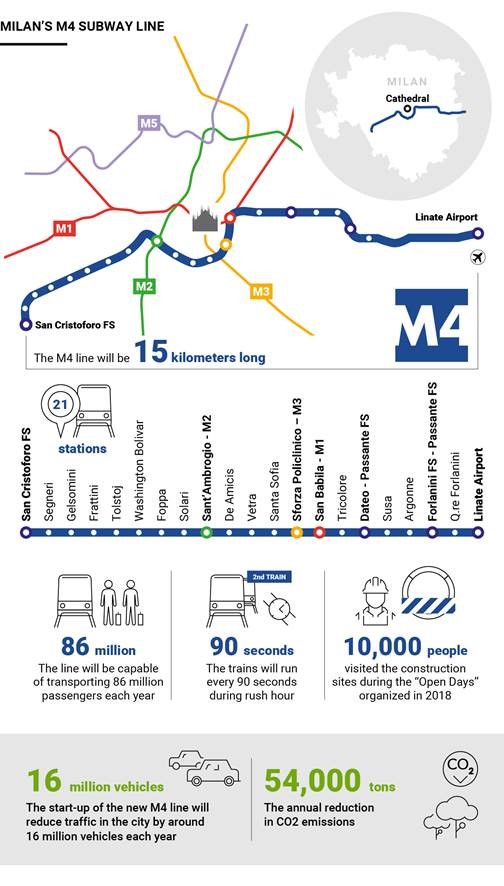
Just two words sum up how Milan’s new M4 metro line will change the city: 15 minutes. That is how long it will take, once M4 is up and running, to reach the Linate airport from Milan’s city centre, reducing the amount of time it takes to reach the rest of Europe from the heart of Italy’s business capital.
Set to be 15 kilometres long, the line will have 21 stations, crossing the historic centre in just 30 minutes to connect areas on the eastern and western sides, from the Linate airport to the San Cristoforo station.
The M4 will be able to transport 86 million people a year, thanks to the frequency of its trains: every 90 seconds during peak hours.
Giving residents their say
The M4, funded by a public-private partnership with construction led by a consortium headed by Salini Impregilo, was designed from the very start to encourage residents to be involved. In 2018 alone, 10,000 people took part in the “open days” organised to let the curious visit the new stations. So anyone could have their say about the M4 project, giving feedback, presenting a proposal or raising criticism or concern, be it from a neighborhood committee, a business owner or an individual resident.
This led to certain decisions being taken to minimise the impact of the construction works on nearby residents, such as disposing the earth excavated in the tunnels by using underground conveyor belts instead of trucks; or working with the superintendent’s office to display the archaeological finds unearthed during the excavation at the Archaeological Museum of Milan.
These are just a few of the things that stand out in what is being called “the neighbourhood’s metro,” a project that aims to let local people have their say not only from the moment it opens its doors, but also while it was being built.
Sustainable mobility for Milan
The M4 will have a substantial impact on Milan’s mobility. When it starts operating, the city’s entire metro network will be 118 kilometres long, becoming Europe’s sixth largest.
It is estimated that the start-up of the new M4 line can reduce traffic in the city by around 16 million vehicles each year, with an annual reduction in CO2 emissions of up to 54 thousand tons.
But it will still take some time before the M4 is ready. To date, 56 construction sites are open across the city, where a combined total of 1,500 people work. Meanwhile the tunnel-boring machines (TBMs) are digging away underground to speed up the time necessary to complete the job.

In January, excavations began on the central section of the route, which includes eight stops (Tricolore, San Babila, Sforza Policlinico, Santa Sofia, Vetra, De Amicis, Sant’Ambrogio, Parco Solari). For this section, larger TBMs are being used, measuring 9.15 metres across, so that passengers can disembark directly inside the tunnels, reducing the space occupied by the stations to a minimum.
The eastern part is already completed, while the west is 72.5% done. Milan’s Mobility Superintendent Marco Granelli said in December the goal was «to stick to our time table: in January 2021 we will open the first section from Linate to Forlanini, the section from Dateo to San Babila at the end of 2022 and then the whole line in July 2023».
Technology at the service of infrastructure
This high frequency will be thanks to one of the many innovative technologies being deployed on the project. There will be driverless trains equipped with a communications system that enables them to can talk to each other through a Wi-Fi network. They will know exactly how far away they are from those ahead and behind them. That means the trains will know whether they can approach the station without the risk of an accident. This will allow the line to carry 24,000 passengers per hour in each direction.
The stations will be equipped with automatic doors, which guarantee a high level of safety for passengers.
The ticket system, managed by Azienda Trasporti Milanesi (ATM), the public transport company, will be “contactless” just like those installed along the other lines as of June 28, 2018. ATM was the first in Italy and among the first 10 in the world to offer its customers the option of using contactless payment to pass through its turnstiles.
ATM has equipped all 113 subway stations with dedicated turnstiles using POS and the QR code, both inbound and outbound, which can be triggered by waving a smartphone on top of the POS sensor. To use the service, commuters need to register with their smartphone or smartwatch to which their payment card has been linked. In addition, the system calculates the journeys made by each commuter over the course of a day and charges the most advantageous rate should discounts be available.
This technology is used in other cities, including London, Moscow, Chicago, Singapore and Vancouver.

